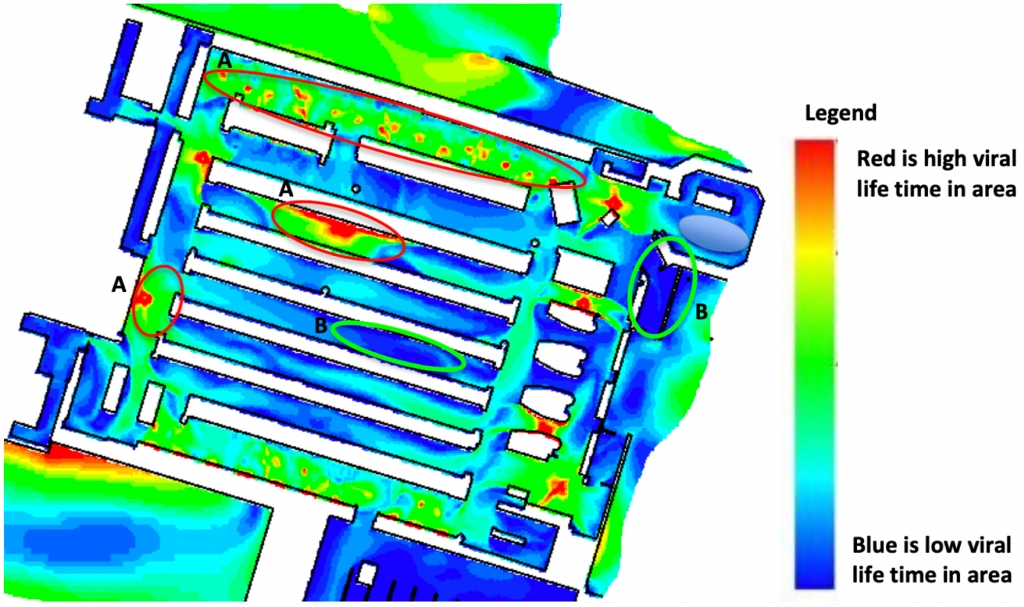‘Opening up indoor spaces as safer environments through Airborne Infection Reduction’
IBPSA-England Webinar
Co-simulation for advanced building performance assessment
23rd March 2022
Abstract: The next generation of building ventilation systems is one that is designed to limit airborne infection risk. Using available methods to estimate risk, Wirth Research have utilised a combined Dynamic Thermal Modelling (DTM) and Computational Fluid Dynamics (CFD) approach to assess risk and drive the design. Recent works have shown the potential of the simulation of the indoor ventilation and its related airborne infection risk to protect occupants and inform design and policy.
Presentation – PresIBPSA-England-CosimulationBuildingPerformance-v2.pdf
In 2021 Wirth Research won the CIBSE Building Simulation Award using our openAIR methodology. The approach combines dynamic thermal modeling with computational fluid dynamics, making use of the strengths of each tool, to provide a relative measure of transmission risk that can be used to guide design and operation of indoor workspaces.
Presentation – Covid-19 Infection Risk Modelling.pdf
A second entry included an assessment of an industrial bakery. CIBSE-BuildingPhysicsAward-Industrial Bakery.pdf
Airborne Infection Reduction through Building Operation and Design for SARS-CoV-2 (AIRBODS) is a UKRI- funded research programme led by Prof Malcolm Cook at Loughborough University in partnership with University College London, the University of Nottingham, the University of Cambridge, the University of Sheffield, London South Bank University and Wirth Research. It is a 22-month programme due to be completed at the end of 2022 with more details available at https://airbods.org.uk.
At the start of the pandemic Wirth Research carried out a number of early studies in support of understanding ventilation and infection control which are highlighted below.
During normal speech, or coughing, the most common average water droplet size emitted by a human is seven microns in diameter (less than a tenth of the thickness of human hair – about the size of common pollen) and these droplets can contain and transmit Coronavirus.
Evaporation of these droplets kills the coronavirus within them, hence conditions that encourage quick evaporation is favourable. Equally conditions where droplet evaporation isn’t favourable can increase transmission. Such as low temperature/high humidity environments, as has been seen in low temperature food processing plants worldwide.
In still air and ambient conditions, these droplets typically evaporate within 2m, hence why the 2m social distancing rule is so effective.
In enclosed spaces such as offices, supermarkets or any work facility, the moving airflow caused by HVAC can have a major effect on the chance of Coronavirus transmission, as the environment is no longer “still air”.
Social distance distancing is designed to limit the amount of person-to-person airborne Coronavirus transmission.
The greater the person-to-person social distance – in still air – the lower the risk of Coronavirus transmission, as greater social distance allows the airborne virus to disperse into a greater volume of air, reducing its concentration, before it can be is ingested by another person nearby:-
Using Wirth Research’s high-resolution and validated Computational Fluid Dynamics (CFD) technology, the airflow surrounding people in any indoor environment (such as a shop, food manufacturing plant or office) can be assessed for its occupant safety to help Clients determine and immediately implement mitigation strategies to avoid transmission of Coronavirus by either changing the occupied spaces usage, or by introducing physical airflow mitigation by modifying the HVAC to improve safety
The openAIR is process is carried out in the following stages:
The below movie shows an output from an analysis of a supermarket. The complex airflow movement around and through a supermarket has been modelled, allowing measures to be put in place to minimise viral transmission.
Example Results Output
The following image shows an example heat map from a generic store which shows the viral lifetime profile within the store. The red areas show high viral life time, and it is these areas which we would aim to minimise/remove.

There are some types of airflow that can not only compliment and reinforce the benefits of social distancing, but can either significantly reduce or even entirely eliminate the need for social distancing altogether:-
Such a safe area is called an openAIR Vertical Airflow Zone (OVAZ) and is created by a combination of both:-
Vertical airflow: Fresh, virus-free airflow, which flows in a direction that is perpendicular to the floor (i.e. airflow that either is goes either straight up or straight down in the region where people are present) will naturally carry the airborne virus away from a virus emitting person – wherever they are. As the airflow direction isn’t horizontal, the virus is immediately removed from the occupied zone without reaching anyone else, therefore the risk of transmission is significantly reduced or even eliminated:-.
Fresh airflow:
OVAZ will significantly reduce/eliminate the risk of airborne virus transmission.
OVAZ will also significantly reduce/eliminate the chance of surfaces becoming contaminated by airborne virus settling on them.
A confined space – such as a passenger lift – can be made safe by retrofitting openAIR Technology to give vertical airflow, which is recirculated and continuously cleansed by the Continuous Autoclaving System:
Further reading on coronavirus airborne transmission can be found at the following links:
https://aip.scitation.org/doi/10.1063/5.0011960
https://www.globaltimes.cn/content/1182008.shtml
https://www.bbc.co.uk/news/uk-england-northamptonshire-53762233